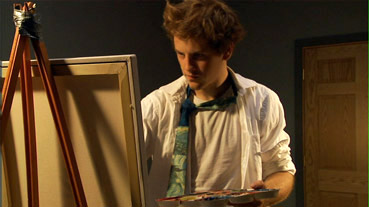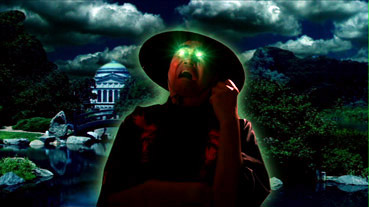|
Marcus wants to be a ninja. Whether he deserves to be one is another matter, but that's his dream. To that end he's been training with ninja master Nobu, an American who dresses and talks like a cartoon Japanese sensei, and now the time has come for Marcus, along with his fellow pupils, to receive their black belts. Except he doesn't get his. Sensei Nobu doesn't think he's ready. It's not surprising. Marcus (played with cocky assurance by John LaFlamboy) is, after all, a bit of a dick, and his black belt refusal was probably justified on the grounds of his arrogance and delusions of self-importance. When he angrily protests, Nobu administers a short, sharp lesson in the enlightening experience of pain. Picking himself up, he does what any fallen warrior might do and takes a job as a cinema usher.
It's worth noting at this point, assuming you haven't worked it out already, that none of this is meant to be taken even remotely seriously. So if the cocky, permanently leather-jacketed Marcus wants to move from the monochrome world of urban ninja training into the full colour environment of movie-house servitude then why the hell not? This particular cinema, after all, appears to be a magnet for wannabe achievers in other fields. There's Jack (an engaging Anders Erickson who at times looks like a young Matthew Perry), a struggling artist of some talent whose inspiration has dried up. And then there's his usherette girlfriend Sharon (Lauren Bishop), an aspiring actress, and Jack's best friend Nick (Greg Brookens, the director's brother), a dorky science fiction geek who wants to be comic book writer. (This is just a wild stab in the dark, but I'm wondering if Matt Brookens, aspiring filmmaker and director of this very movie, also once worked in a cinema.*)

Anyway, Jack is given the job of showing Marcus the ropes and Marcus continues to act like a dick. He supplies dope to both Jack and Jack's casual-use father, then laughingly shops them both to Jack's more puritanically minded mother, and in no time at all has zeroed in on Sharon's dissatisfaction with her relationship (with good reason, as it happens) to grab her from under Jack's nose. "Great art comes from great pain" visiting cult filmmaker George Romano assures Marcus, and he appears to be on to something, as when Jack suffers, his artistic vision returns. His latest painting (which we never get to see – you can decide for yourself if this is a concession to the budget or a deliberate gag) particularly impresses his super-camp boss Charlie (Jake Hames), whose billionaire aunt Martha Russell likes it enough to offer Jack a sizeable commission, if he can just produce another to convince the investors...
First films, specifically independently made first films, are tough. They take a lot of time, effort and coordination to put together, and often involve people working for nothing in their spare time as favours to friends to produce something you're not even sure will ever get finished, let alone find an audience. You've got no money and are winging the whole thing on favours and improvised solutions. Both Camus and I have had first-hand experience of this – the memory of trying to execute a smooth crane shot with a heavy DigiBeta camera while roped to a wooden box on the arm of a large piece of farm machinery is likely to stay with me forever, especially as my legs had just exploded in large green blisters that baffled local doctors, the result of some horrible insect peculiar to the Norfolk woods. Oh yes, low budget independent filmmaking is a barrel of fun.
The Art of Pain is, I have to say, a lovely title, having a narrative logic and yet open to a number of readings, and its matched by its superb tag line "Inspire an artist – ruin his life." It's the low budget calling card of the aforementioned Matt Brookens, who is at present also handling the DVD release. That it's a first feature is unlikely to escape even those coming to it without foreknowledge of the fact – the film has both that engaging don't-care recklessness that studios tend to suffocate and an occasional looseness that might benefit from the voice of experience. This is most evident in the scenes where characters just sit and talk, or at least a fair number of them – the film's Clerks-similar setting calls out for the sort of smart dialogue that made that film such an indie hit, but too often its not quite there. Jack and Nick talk a lot and their conversations often have an ambling, semi-improvised feel, but without the naturalism this might suggest or the wit that a sharper script might have imposed. Fortunately this is not universal to every scene, not by a long shot. Elsewhere the right words and the right performer find each other with amusing results. Troma kingpin Lloyd Kaufman is great fun as ungracefully ageing director George Romano, Dale Chapman amuses as Jack's secretly dope-smoking father, and in a microscopic but quietly hilarious turn as investigating detective McCracken, John Turk's mock sincere delivery made me laugh out loud.

When Brookens tells his story through pictures rather than words the film really springs to life: the visualisation of Nick's story for the Skunk Ape comic he and Jack are working on blends live action with comic artwork to neat effect; Sharon's fantasy vision of bad boy Marcus on a motorbike amusingly recalls Steve Martin's sadistic dentist from The Little Shop of Horrors; a hallucination sequence plays like a drugged-out live action pop-art painting; and one character falls to his death and lands in a sparkly, galactic picture-book version of the afterlife.
The filmmaking itself also provides its share of pleasures, as with the niftily staged martial arts sequences or the beautifully arranged dolly shot in which ninjas drop from scaffolding behind the walking Marcus. Marcus's kung-fu zombie nightmare may only have been included because Brookens always dreamed of staging such a sequence (I'm guessing here), but it's still carried off with considerable aplomb. And in spite of my above gripes about the dialogue lulls, the film still scores a good many genuine laughs, in the pissed-off Jack's angry greeting of a cinema customer with "Welcome to the movies and shit!"; in the exchange of emails between Charlie and Aunt Martha (you need to see this one to understand why it's funny); in the on-the-nose smiley condescension of the new employee training video; in Nick's secret musical hobby; in the clunky rehearsals for a stage production of Scarlet Letter 2 (knowing the original in one of its forms helps the appreciation here); and in an inspired funeral sequence that successfully melds the hilariously surreal – Amazing Grace is played with eye-watering sincerity on a Theremin – with a faultlessly executed old gag involving a sword and a thirst for angry retribution.
The Art of Pain could have done with some re-writing and tightening up of some of the dialogue scenes, but as ever this is very much a taste thing – I can pretty much guarantee that a group of media students I worked with a few years back would love the whole movie to death. Either way, it's a smartly made, very well shot and persistently likeable work whose best moments are inventive and enjoyable, and it's they that bode well for Brookens's future projects and suggest that with the right script he could produce a genuine cult movie of some note.
The Art of Pain was shot on HD rather than film, but Brookens and cinematographer Daniel Kenji Levin have done a sterling job of given it a filmic look. I suspect the DVD was mastered from a 35mm transfer of the HD original (this always helps give HD a film feel), which would explain the hairline scratches that are occasionally visible. Some digital grain in the darker interior scenes aside, the 1.78:1 anamorphic transfer is generally excellent, contrast and sharpness looking damned good even upscaled to an HD TV, while the colour is downright gorgeous in places.

The soundtrack is Dolby 2.0 stereo only but it's clear as a bell and has a very decent dynamic range and some good bass work.
Deleted Scenes (6:33 total)
Six brief deleted scenes. The first, involving the appearance of 'Sneaky Pete', I can happily do without, but a brief one involving Marcus, a gun and a mirror has an amusing punchline, and the inclusion of the full version of the cinema employee training video is most welcome.
Trailer (1:59)
A very well cut trailer that lays out the plot clearly enough for me to suggest you watch it after rather than before the film. Which is a bit odd for a trailer, of course. It does sell the film well, though.
Teaser (0:35)
A nifty enough hint of things to come without revealing specifics.
Bloopers (4:47)
A mildly amusing collection of fluffed lines, misbehaving props, set-invading dogs, green screen flailing about and general fooling around. George Romano's explicit explanation of past drug experiences to a supremely uncomfortable-looking usherette is a highlight.
Mitchumentary (4:45)
A gag featurette on sound recordist Mitch Logan proves a somewhat laboured in-joke that is probably a lot funnier to those who worked on the movie.
Son of Roni (12:07)
A 2007 short film by the Brookens brothers that plays as a live action cartoon made by a group of friends for their own amusement. Efficiently done for the most part and wearing its cheesy effects with pride, it does have a couple of good gags ("beer that makes you die”), but a couple of the performances play to a far distant gallery (brother Greg is the worst offender here) and lovers of subtle humour are likely to find their tolerance severely tested.
Skunk Ape trailer (1:15)
A supercheap but rather funny promo for the Brookens brothers' 30 minute 2003 short Skunk Ape!?, introduced by Matt and Greg themselves.
Silly and obvious in places but imaginative and genuinely funny in others, The Art of Pain is the sort of film that could develop a real following if it finds the right audience. It didn't all work for me, but much of it did and its best moments point the way to possibly fine things to come. The Brookens brothers may have a fondness for loud, daft humour, but I seem to remember that's how a certain Sam Raimi started out, a parallel strengthened by the ghoulish effectiveness of the film's zombie sequence. The in-house produced DVD is a professional job and really delivers on the transfer quality. For now you can buy the disc through the movie's web site www.artofpainmovie.com,** but it may well become more widely available in the not too distant future.
|